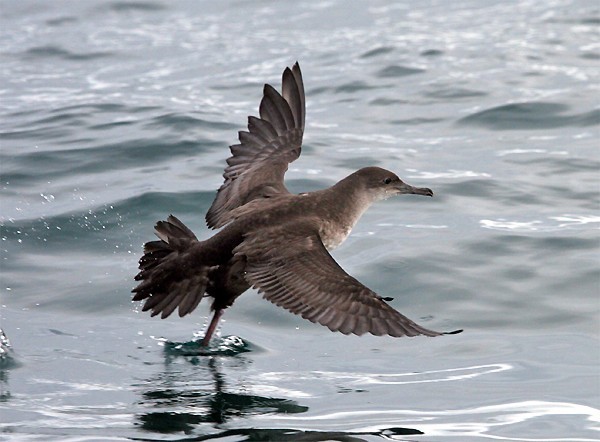Seabird programme to track Europe's seabirds beyond the blue horizon
"We know more about the journeys of albatrosses in the Southern Ocean than we do about some of the seabirds around our own shores," says Dr Ellie Owen, a seabird scientist working on a European Union-funded project to track the movements of seabirds along the Atlantic coastlines of the UK, Ireland, France, Spain and Portugal.
The project, known as FAME — the Future of the Atlantic Marine Environment, is tracking the movements of seabirds to pinpoint areas that are important for these ocean travellers. This knowledge should assist the selection of marine protected areas which are vital for the survival of seabird species, some of which are declining rapidly. Using technology similar to that found in car 'sat-nav' systems, the researchers tape tiny trackers to the backs of seabirds. These devices take a reading every 100 seconds, allowing the scientists to pinpoint their subject's movements accurately between the birds' nesting colonies and the areas of sea the birds use to find food. Accurate to within a few metres, the devices are providing the team with breathtakingly detailed information that they could have only dreamt about a few years ago.
Ellie Owen said: "The sights and sounds of thousands of seabirds packed into dense nesting colonies along our most rugged coastlines create some of our greatest wildlife spectacles; but there are concerns that these colonies are dwindling as some species are struggling for survival. Up to now we've known very little about the movements of these birds when they venture out to sea to find food. For example, we know how many Kittiwakes there are in the UK, and we know they've declined by 30% between 2000 and 2010. But we don't know where these ocean travellers are going to fish for their chicks' suppers. But now, just when these birds need our help, we're on the cusp of filling this information void with vitally important data."

Kittiwake, South Gare, Cleveland (Photo: James Thomas)
From the south of Spain, along the Atlantic coast of Europe north to Fair Isle (between Orkney and Shetland), seabird scientists will be studying a variety of seabirds, ranging in size from the goose-sized Gannet to sparrow-sized storm-petrels. Although seabirds nest on cliffs and islands, they all depend on the sea for their food and, ultimately, their survival. In the UK, scientists are working at five centres along the Atlantic coast: Fair Isle and Orkney in northern Scotland, Colonsay in the Hebrides, Bardsey Island in Wales, and the Isles of Scilly.
With its teeming seabird colonies, the Hebridean island of Colonsay is an important location for the scientists. Working in challenging conditions — battling the elements and the island's rugged terrain — Ellie and the team are adding to our understanding of seabirds. She said: "European seabirds face a variety of threats from dwindling food supplies, climate change, entanglement with fishing gear and pollution. By recording these birds' movements we are building a greater understanding of their requirements so we can begin to give these species the protection they need."
In the UK, the FAME project will be working with the following seabird species: Fulmar, Shag, Kittiwake, Guillemot, and Razorbill. Elsewhere scientists will be involved with other seabirds, including Gannet, European Storm-petrel, Madeiran Storm-petrel, and Balearic and Cory's Shearwaters.
RSPB seabird scientist Mark Bolton said: "We know that some species are declining rapidly. For example, the Balearic Shearwater — a dove-sized relative of the albatross — is reckoned to be facing a greater threat of extinction than the Tiger, Mountain Gorilla or Giant Panda."

Balearic Shearwater, Portland, Dorset (Photo: Tom Brereton)
Rory Crawford is a seabird policy officer for the RSPB. "Given that the creation of protected areas for seabirds — and marine wildlife more broadly — lags severely behind terrestrial conservation measures, this work is hugely significant. Knowing the where and why of seabird foraging will be crucial in informing the designation of Marine Protected Areas across the northeast Atlantic. This information will also be vital in shaping marine management decisions, as the interactions between seabirds and marine industries become clearer. Data from the GPS tags and depth loggers will provide key information on how diving seabirds might interact with new marine renewable energy devices — particularly wave and tidal technologies. Governments have the tools to protect seabirds at sea through both domestic and European legislation; it's high time that the most important sites were identified and formally protected and, through FAME, RSPB are making a positive and proactive contribution."
The Future of the Atlantic Marine Environment project is funded by the European Commission through its programmes: the European Regional Development Fund, the Atlantic Area Transnational Programme. The project includes the RSPB's partners in Ireland (BirdWatch Ireland), France (LPO), Spain (SEO) and Portugal (SPEA). Other partners include WavEC — a renewable energy organisation — and the University of Minho. In other parts of Europe the project will be working closely with fisheries to gather data on seabird by-catch to inform measures and protected areas to reduce this slaughter.

Guillemot, Farne Islands, Northumberland (Photo: Richard Bedford)
Today the RSPB is urging the public to call for the urgent designation of marine protected areas around the UK's seas by signing an online pledge.
Martin Harper is the RSPB's Conservation Director. Commenting on the launch of the pledge, he said: "We already have the national and international laws that should be protecting marine wildlife, including seabirds. There is now an urgent need to implement them and designate those sites that need protection. Unfortunately, the needs of some of our most precious sealife are not being considered properly. As things stand, there is a real risk that seabirds, such as the Kittiwake, will remain unprotected when feeding at sea."
To sign the online pledge please visit www.rspb.org.uk/marine.

